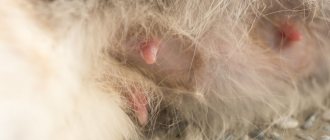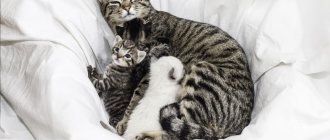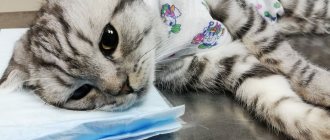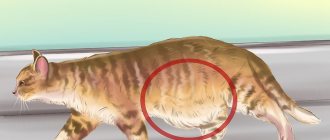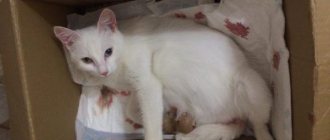Like any expectant mother, a cat needs a certain attitude and attention. To take good care of it you need to arm yourself with the necessary knowledge. This is the knowledge we will try to provide you with.
The best age for a cat to become pregnant for the first time is a year and a half. Their reproductive age is quite long: until very old age.
Purely theoretically, a cat can become pregnant at 15-20 years old. But in real life, this rarely happens, and if it does happen, the pregnancy is quite difficult.
Signs of pregnancy
Of course, only a veterinarian can say for sure whether a cat is pregnant or not. But you yourself can notice something:
- the cat becomes unnaturally calm and affectionate, and suddenly becomes a homebody;
- the cat's appetite increases, it feels like she is eating for two;
- there is an impressive weight gain;
- The cat's nipples become larger;
- she began to go to the toilet more often.
Accurate ways to determine pregnancy in a cat
- Ultrasound. It makes sense to carry out no earlier than two weeks after fertilization.
- Palpation. The method is applicable only to a veterinarian; an inexperienced owner should not do this. Palpation should also be carried out no earlier than 14 days. In 30-40 days, an experienced specialist will be able to determine even the number of kittens.
- X-ray. Using this method, a cat’s pregnancy can be determined closer to one and a half months, when the skeletal system of the kittens begins to form.
- Donating blood for relaxin.
By the way, female pregnancy tests are not suitable for animals.
Stages of pregnancy
There are three main stages of pregnancy, each of which lasts three weeks.
- The first is characterized by toxicosis, sometimes bouts of vomiting. If your cat's condition is of concern, call a veterinarian. He will select drugs that will ease the course of toxicosis.
- The second stage is characterized by weight gain and swelling of the nipples. Do not try to determine how many children a cat is carrying by palpation - this may cause miscarriage.
- At the third stage, the cat's belly grows noticeably and its sides become very swollen. The animal sleeps a lot and goes to the toilet often.
Stages of pregnancy
In obstetric practice, there are three stages of pregnancy, which include:
- egg period,
- embryonic or germinal,
- fetal or fertile.
Each of these periods is characterized by its own metamorphoses:
- some can be seen with the naked eye by the changing behavior and appearance of the animal,
- To determine others, special research methods are used, for example, ultrasound.
You should know it! In practice, such an examination is not often resorted to, only if there is evidence for it.
If you divide a cat’s pregnancy by week, the following picture emerges:
- The first week is characterized by the fragmentation of the zygote (fertilized egg) and the formation of the morula - a compact mass of blastomeres enclosed in a transparent membrane.
- In the second week, the morulae descend into the uterine cavity. Division continues, resulting in the formation of blastocysts, which are distributed along the horns of the uterus.
- The third week is accompanied by the “hatching” of blastocytes and the transition of pregnancy to the embryonic stage.
- The fourth and fifth weeks are the laying of the membranes, the formation and differentiation of tissues of future babies and the formation of the placenta.
- The sixth, seventh, eighth week is the final fetal stage, characterized by further development of the fetus, an increase in their mass and the formation of internal organs.
- At the end of the ninth week, birth occurs.
Based on the above diagram, you can easily calculate how long pregnancy lasts in cats. On average, fruiting is 59 days. The duration largely depends on the breed, age of the expectant mother, her individual characteristics and the degree of multiple pregnancy; the period can vary from 55 to 62 days.
How long does a cat's pregnancy last?
The shortest pregnancy period for a cat is 53 days. And the longest is 72. It can depend on many factors: the breed, the number of kittens, and the health of the animal. It has also been noted that cats with long hair bear offspring longer than those with short hair.
The cat may also go into premature labor. They can be provoked by diseases, stress, careless jumps, etc.
Visit to the veterinarian
Before breeding an animal, competent and responsible owners carry out a set of preventive measures to prevent health problems during pregnancy:
- vaccination against infectious diseases;
- deworming (treatment against worms);
- treatment against external parasites (fleas, lice, lice, etc.).
During the period of gestation, such procedures can lead to miscarriage, premature birth, stillbirth, deformities, the birth of non-viable offspring and even the death of the pregnant female.
The owner can notice the first signs of pregnancy in his pet no earlier than the third week after mating with a cat. The cat's mammary glands turn pink, her belly becomes rounder, her appetite and behavior change. Vomiting, drowsiness, and frequent urination may occur. However, these signs are not clear in all animals. Some owners discover an interesting situation for their pet when the kittens of a pregnant cat begin to move. And this happens already 1 - 2 weeks before birth.
The most accurate way to confirm pregnancy is by performing an ultrasound examination at a veterinary clinic. The procedure is carried out no earlier than the 21st day from the moment of mating. The veterinarian will determine not only the fact of pregnancy itself, but also the number of fetuses.
In addition to an ultrasound of the abdominal cavity, a veterinarian will conduct a clinical examination of the animal and, if necessary, prescribe a biochemical blood test. If the cat does not suffer from chronic diseases, then further observation by a doctor will not be required.
During a visit to the veterinary clinic, the owner can receive advice on feeding, care and maintenance of a pregnant pet in a particular case. If necessary, the animal will be prescribed vitamin and mineral supplements. They should be used strictly as recommended by a doctor.
Development of kittens by trimester
- In the first trimester, the egg is fertilized and attached to the walls of the uterus. Gradually the embryo grows and by the end of the second week it becomes about 10 mm. By the end of the third week, the paws are visible and internal organs are born.
- In the second trimester, the embryo gains weight and its bone skeleton strengthens. The brain begins to form.
- By the beginning of the third trimester, the baby's size reaches 8 cm and acquires the external characteristics of a cat: a tail grows, fur appears and color acquires. By the end of the third trimester, the kitten gains more cm. 5.
Features of caring for a pregnant cat
No special care is required for a pregnant cat. Just follow some guidelines:
- A pregnant cat should not walk outside, there is a high probability of contracting an infection.
- She should not climb to heights because pregnant cats become terribly clumsy and can easily fall.
- Do not use any medications or anti-flea products without consulting your veterinarian.
- The cat needs to be fed complete nutritious food, but there is no need to overfeed to avoid problems with the passage of kittens through the birth canal. Monitor your pregnant pet and if you think something is wrong, contact your veterinarian.
- It is better if the expectant mother is separated from other animals.
- It is recommended to take your cat for an ultrasound a few days before giving birth to know how many kittens there will be and whether everything is fine with them.
What should the owner do during childbirth?
When all the symptoms that the animal will give birth are obvious, you need to prepare a place where the cat and kittens will live.
This secluded nest must be protected from drafts and prying eyes. A regular box or a special cat house is suitable for this. It is also worth worrying about the soft bedding on the bottom of the house. But you shouldn’t use expensive fabric, as it will have to be thrown away after the birth. During contractions, different animals may behave differently . For example, the breed of Scottish cats begins to rush around before giving birth. Your beloved pet may climb onto a closet, hide under the bed, or hide in the nightstand. In such a situation, the owners should calm and caress the animal, moving it to a cozy house in which it should get used to it. If the animal nevertheless gave birth outside the cat’s house, then you need to take her and the resulting offspring and move them to their place.
No entries found.
Interesting: The birth of kittens and their care
Nutrition for a pregnant cat
A pregnant cat should receive high-quality and complete food. And if the animal is accustomed to eating dry food, then buy food intended for feeding such animals.
If you feed your pet natural food, which is preferable, then after consultation with a veterinarian, add a vitamin and mineral complex to the diet.
While on natural feeding, the cat should receive the following products:
- lean meat: chicken, beef, turkey;
- porridge, they can make up up to 30% of the diet;
- fermented milk products once a day;
- vegetables;
- offal occasionally;
- eggs.
For about two weeks the animal is fed 2 times a day. And later they switch to three meals a day with increasing portions.
Later, the kittens begin to grow actively and the cat develops a voracious appetite. But she cannot eat very much at one time, so she needs to switch to eating 4-5 times a day.
What to do if your cat is pregnant?
A cat can become pregnant for the first time at the age of 5-9 months, but this also depends on the breed, size of the pet and the conditions under which it is kept. When a cat is ready to be a mother, her behavior changes and she begins to go into heat. It is not recommended to breed during the first heat: it is better to wait until the animal is one year old.
You can tell that your cat is about to have kittens by the following signs:
- Swelling and discoloration of the nipples to pink or reddish. Often the nipples become hot to the touch;
- Lethargy and reluctance to move. The cat rests and sleeps more, almost does not play with the owner;
- Change in appetite. At the beginning of pregnancy, the cat does not want to eat, and then she eats for three;
- Toxicosis. An unpleasant symptom manifested by nausea and nervousness;
- Frequent urination. If there is no change in the form of urine, there is no need to worry;
- Weight gain. Such an obvious sign, like the rounding of the abdomen, appears by the month of pregnancy of the cat.
You can feel the kittens in the stomach as early as 3-4 weeks of pregnancy. Don't do this yourself - you could accidentally harm fragile babies.
How long does a cat's pregnancy last?
If you are the owner of a cat that you plan to breed in a while, or your pet is already pregnant, then you are probably wondering how long her pregnancy will last. Usually, nine weeks pass from the moment of mating until the kittens are born, but this is an average, that is, imprecise period.
In fact, a cat carries its babies from 58 to 72 days, and in some cases this period can drag on even longer - this is already a pathology and requires medical intervention.
In order to have an idea of when exactly your pet’s kittens should be born, you should know exactly the date of her mating with the cat - the countdown begins from this day. In some cases, pregnancy in Sphynxes and short-haired cats lasts slightly less than in long-haired animals.
In addition, the duration of its course may be influenced by the number of fruits; The more kittens a cat bears, the greater the load placed on her body and the quicker the pregnancy usually ends.
Be that as it may, even if there are about a dozen kittens in the litter, under no circumstances should they be born before 58 days have passed from the start of pregnancy - premature babies are most often not viable and soon die.
Quite often, a cat “survives” pregnancy; this may be caused by stress or a small number of babies - two or three - in the litter.
What should be considered an excessively prolonged pregnancy? To form a viable kitten, it is necessary that at least 58 days pass from the moment of conception to birth; a week beyond this period, during which labor does not occur, is not considered a pathology and does not require calling a veterinarian. If the cat has not lambed on the 66th day of pregnancy, then it is better to consult a specialist about this.
Pregnancy in a cat is usually divided into three periods of equal duration - trimesters. During the first of them, the fruit reaches a centimeter size; by the end of this period, his head is formed and the formation of limbs, as well as external genitalia, begins.
In the second trimester, the fetus acquires a muzzle and even teeth; its dimensions increase to five to six centimeters. In principle, by the end of this period the fetus visually represents a greatly reduced copy of an ordinary domestic cat.
During the third trimester, the kitten develops fur and its ears and tail become longer; by the 58th day of pregnancy it is fully formed and viable.
Interestingly, females develop faster than males, and when they are born, they are generally stronger and more active than their little brothers.
By comparing the timing of puberty of the average cat and its average life expectancy, it is easy to calculate that one animal can hypothetically become the mother of more than a hundred kittens.
In fact, it is not recommended to breed a cat more than once or twice a year, because pregnancy and childbirth greatly wear out the animal’s body.
If your cat is not a valuable representative of its breed and there is no queue of those who would like to adopt a kitten from her, it is better not to breed unnecessary animals and sterilize your pet in a timely manner.
How is a cat pregnant?
The development of kittens in the womb of a cat mother occurs very quickly. As in humans, pregnancy in cats is usually divided into periods of 3 weeks:
- 1-3 weeks. This trimester is not characterized by obvious manifestations - the cat simply begins to sleep more. By the third week, the nipples become larger and the appetite increases. It is better to show the cat to a veterinarian - you can do an ultrasound on the cat;
- 4-6 weeks. Pregnancy becomes clearly defined: the cat’s tummy becomes rounded, and the pet itself rests more. You can feel the kittens moving;
- 7-9 weeks. The belly grows very quickly. The cat sleeps and eats a lot, and begins to look for a nest for future offspring.
Childbirth in a cat. Last days of pregnancy
From about the middle of the second month, the animal is prohibited from actively palpating. These days, the embryos acquire a cylindrical shape and move into the abdominal cavity. During this period, the female becomes noticeably rounder. But if she is pregnant with only one or two kittens, then her “interesting situation” may remain unnoticed for a long time.
By the 42nd or 50th day, kittens acquire hair. They become active. The movement of the fetus in the womb can be seen with the naked eye. At the same time, the mother’s appetite may disappear completely.
Childbirth in a cat will be normal if the animal’s health is properly taken care of during pregnancy. The female should receive balanced food in sufficient quantities. Her diet must include:
- meat and fish products,
- milk,
- dry food or canned food,
- vegetable supplements,
- vitamins.
A pregnant female should move a lot. But it is necessary to ensure that she does not make any effort or make sudden movements. A pregnant young female can jump and play like a kitten. Whenever possible, jumping and somersaults should be stopped.
Caring for a pregnant cat
It is important to provide your pet with comfort and peace during this difficult period for her. Pet your cat more, please it with treats and don’t leave it alone for a long time.
Due to frequent visits to the toilet, the owner will have to constantly clean the litter box. You should also switch your cat to specialized food for pregnant women. Offer your cat foods with calcium: cottage cheese and low-fat kefir. The expectant mother definitely needs to drink a lot - constantly replenish the bowl with fresh water.
You should prepare a nest for future kittens in advance. A box covered with a soft cloth is suitable for this. The litter should have no loose threads and smell good. Introduce the cat to the nest: to do this, put it in a box and treat it with a treat. If the cat tries to jump out, you will have to be patient to prove to your pet that the area is safe.
Write down the number of the nearest veterinary clinic to quickly respond in case of trouble.
Feed your pregnant cat correctly
Speaking about caring for a pregnant cat, it is worth saying a few words about the animal’s diet. During this period, your cat needs protein and calcium. However, if you feed your animal dry food, do not change it. It is enough to simply purchase food of the same brand, but marked “for pregnant cats.”
If you use dry food to feed your cat, then it is not necessary to introduce additional vitamins into the diet. However, if you feed your cat natural products, consult with your veterinarian on how best to adjust its diet.
When caring for a pregnant cat, you should also remember that in the second half of pregnancy, the cat’s body is in great need of proteins.
Possible pathologies
- uterine inguinal hernia - protrusion of the uterus through the inguinal canal;
- bleeding;
- polyhydramnios;
- twisting of the uterus (most often occurs due to injury);
- death of kittens in the womb.
Danger signs
- Temperature rise.
- Smell from the vulva.
- Bloody issues.
- Refusal of food.
- The animal is inactive, lethargic and depressed.
- If you observe these signs in your pet, go to the vet immediately!
Signs of imminent labor:
- the cat is trying to find a cozy and secluded place;
- behavior becomes either unnaturally affectionate or aggressive;
- body temperature drops to 37 degrees;
- the animal refuses to consume food;
- the cat licks itself too thoroughly
Read how to give birth to a cat>>>
The timing of labor depends on many factors:
- Age. The older the animal, the longer the pregnancy lasts, since metabolism slows down with age.
- Number of offspring. The more kittens, the sooner they will be born.
- Emotional condition. If the cat is stressed, the birth may be delayed.
- Features of the breed.
See also: Childbirth in Sphynx cats
Preparing for childbirth, behavioral changes
If the pregnancy is normal and there are no health problems, by the 50th day of pregnancy the following set should be prepared in the house:
- Sturdy box with low side. The cat should freely enter and exit the “nest” without clinging to the side with its belly.
- Several pairs of sterile, latex surgical gloves.
- Medical pipettes or suction, for forced cleaning of the respiratory tract if the kitten does not cough on its own.
- Sterile or boiled thread.
- Surgical or antiseptic-treated cosmetic scissors.
- Liquid and powder antiseptics purchased at a veterinary pharmacy. Human medications can be toxic to mother and kittens.
- Zelenka and cotton swabs for lubricating the umbilical cord.
- Clean cotton diapers, flannel. Several small terry towels for rubbing kittens.
- Levomikol ointment or an analogue - in case of stoppage of fetal movement in the birth canal.
- Clean water bowl.
- Powdered infant formula from 0 months is a cat milk substitute.
- Pre-agreed conditions for the veterinarian’s visit and a telephone number for remote consultation.
- Oxytocin or an analogue – stimulation of contractions and labor.
- Sulfocamphocaine – stimulation of cardiac activity.
- Potassium gluconate – support in case of prolonged labor. A solution of up to 10% can be administered subcutaneously; above that, only intravenously!
Take note! For fluffy and “hyper-clean” cats, be sure to prepare: dry and wet wipes, moisture-absorbing diapers. If you don’t provide the “fastidious” with cleanliness, she will wash herself, crawl from place to place, and childbirth will become an afterthought.
You may not need anything other than a box and diapers, but you need to be prepared for everything. From a behavioral point of view, changes may not be noticeable, especially for cats of the “noble” breed. From a physiological point of view, the following signs of impending birth in a cat are observed:
- 24–72 hours before labor begins, body temperature drops to 37 °C.
- Within 24–48 hours, the cat actively licks the genitals, the mucous membranes turn red or pink.
- Not always - the mammary glands become very engorged, and the skin around the nipples becomes hotter.
- The cat may become “disengaged” and inactive.
- 4–8 hours before contractions, the cat “hunches over” - this is due to “training” contractions of the uterus. During this period, the pet becomes very worried and may “call for help” or hide.
- A sharp decrease in appetite. Water or milk is consumed in normal quantities.
Important! A pregnant cat chooses where to build her nest. If the animal does not treat the box well and stubbornly settles down in the closet on your favorite shirts - give in, free up the place you like and arrange it comfortably, the cat will still do it in its own way. Some cats, especially first-time cats, give birth “wherever necessary” - be prepared.
Cat pregnancy is a physiological state from the moment of fertilization until the birth of kittens, otherwise it is called fruiting. This important moment in the life of every female is characterized by increased activity of all systems and the body as a whole.
Childbirth in cats
If you notice that your pet hardly eats, breathes heavily, meows and tries to hide somewhere, then the hour is approaching. And soon she will delight you with fluffy balls.
Cats usually cope with the birthing process on their own and do not require anyone's help, with the exception of pathological births.
Therefore, just provide the cat with peace and unobtrusively observe the process. If she needs help, act!
Help for newborns
- If the kitten is not breathing: remove mucus from the nose-mouth using a syringe, apply a cotton swab with ammonia around it, and shake the baby.
- If the cat has not chewed the umbilical cord: tie the umbilical cord near the belly with a thread and a second time a little further away, cut between the threads. Lubricate the tip with brilliant green.
Why are several kittens born?
A cat gives birth to several kittens at once due to the characteristics of her reproductive system. She can give birth to from 1 to 10 kittens. But on average, there are from 3 to 5 cubs.
Veterinarians recommend giving birth to a cat no more than 2 times a year.
As we can see, cat pregnancy is not so different from female pregnancy. They may also experience morning sickness, gain weight, or have health problems. And here the owners need to be on alert to help their pet!
Normal pregnancy process, stages and timing
In a healthy animal, the process of pregnancy and childbirth occurs without the need for intervention or assistance. In purebred, small, problem cats, childbirth may occur with complications. In more developed countries, there is a special profession - zooobstetrician, a specialist responsible for the favorable course of childbirth, preserving the life and health of the mother and offspring. In “our realities,” all responsibility falls on the shoulders of the owners and general veterinarians.
On average, a normal cat pregnancy lasts 60–65 days, but the period can vary by 7–10 days depending on the breed and body composition of the expectant mother. Conventionally, pregnancy is divided into 3 stages:
- Mating – 3 weeks: after mating, the cat experiences swelling of the mucous membranes of the genital tract, but this does not guarantee pregnancy. Distinct signs are observed from the third week:
- Drowsiness, decreased appetite and activity.
- Requires affection and attention.
- Vomiting (no more than 3 times a day, no longer than 2-3 days).
- Distinct pigmentation of the mammary glands - from light to bright pink.
- An enlarged uterus, which can be detected by a veterinarian by palpation.
- 4–6 weeks:
- Rapid growth of “babies” and “rounding” of the cat. By week 6, the amount of fluid in the uterus increases, and the kittens begin to make their first movements.
- Kittens can be “felt” when gently palpated.
- The cat eats and sleeps more, otherwise behaves as usual.
- 7–9 weeks:
- Kittens are actively moving. The movements are clearly visible to the naked eye, especially if the cat is sleeping.
- Swelling of the mammary glands, release of colostrum.
- Some cats have a whitish vaginal discharge, which is normal.
- Increased anxiety and making a “den”.
Important! “Nesting” is not observed in all animals. A cat with increased social activity will benefit from the foresight of the owners in arranging the place and assisting in childbirth. “Tethered cats” need to be monitored especially carefully; hormones and a “naughty” character can lead the animal to a “breakdown” and rash actions, which can lead to premature birth or abandonment of kittens.



